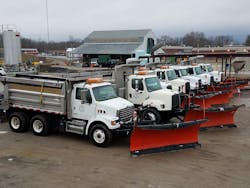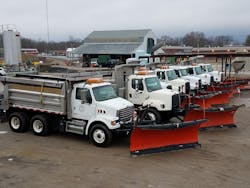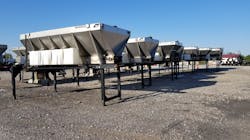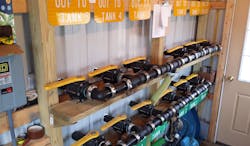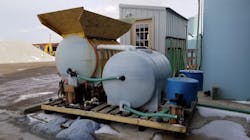One size doesn’t fit all
Those of us who work in areas with inclement winter weather know how important proper winter storm response can be. While only a part of our overall road maintenance responsibilities, our effectiveness when dealing with snow and ice events is certainly the most scrutinized. Nine months of great road maintenance work and public goodwill can be completely wiped out in one mismanaged winter storm. Some agencies steadily outperform others during winter weather response. How do they do it, and what do they know that we don’t? More importantly, how do we get there?
Those are the questions the Johnson County Highway Department was asking during the winter season of 2013-2014. Salt supplies were depleted around our region, and we were fighting more frequent and colder winter storm events than usual. Staff were exhausted from top to bottom as snow event cleanup continued into subsequent winter storms. But public expectation of clear roads did not change, whether on our narrow low-volume roads or our suburban collectors pushing 15,000 vehicles per day. Located just south of Indianapolis, Johnson County is the fifth-fastest growing county in Indiana, due largely to suburban growth in the central Indiana region. Additionally, neighborhood streets account for roughly 22% of the total road miles in our unincorporated jurisdiction, which is rare for a county in our state. Goods still had to be moved, residents still had to get to work, and children still had to get to school. To say we had to get creative during that season to clear the roughly 1,200 lane miles in our jurisdiction would be an understatement.
However, we were watching other agencies finish their storm cleanup consistently faster than we were. We had seen this before in previous seasons but had accepted that we were facing different challenges than our municipal neighbors, such as fewer resources available per mile and blowing snow in rural areas, that required additional time. While this was all true, it was time to stop using this as an excuse for poor performance and develop a new way to deal with winter storms.
The first step toward improvement required learning as much as possible about available technologies and best practices for winter storm response. Through divine intervention, sheer luck, or something in between, we received a mailing for the 2014 APWA North American Snow Conference in Cincinnati during our difficult 2013-2014 winter season and decided to attend. This is where we were first learned the extent of what we didn’t know. While it was clear that improving our winter storm response would be a long-term and ongoing process, gaining access to training resources and making connections with vendors and other government agencies at this conference played a key role in developing a plan unique to our needs.
Our approach to the plan was separated into two main goals: 1) planning as best as we can for things that our outside of our control, such as the weather conditions, and 2) prioritizing implementation of the numerous changes needed to our program that were within our control, such as labor, equipment, and materials. We chose the “snowball” approach to the second goal, implementing the easier changes early on to improve performance while continuing to work on longer-term or more expensive implementations in future years.
Anti-icing and deicing materials were our first point of emphasis. A sand and salt mixture was the historical deicing material of choice for our agency. Prior to the 2013-2014 season we had changed the mixture from a 3:1 sand-to-salt ratio down to 1:1, if for no other reason than to reduce travel time to and from the shop and increase in-area plow times during a shift. As we began to learn how little benefit sand provided in the vast majority of our storm events, especially compared to the problems it caused during storm cleanup and with drainage systems throughout the year, we changed our entire operation over to straight salt. This immediately resulted in faster and more dependable snow melt and a significant increase in shift hours spent plowing snow in the field rather than traveling to and from the shop for more material.
One unconventional but ultimately necessary change for us was an increase in our annual salt usage. Cost savings are an important part of a winter maintenance improvement plan, but we found that we were not using enough salt to truly benefit our operations. Without realizing it at the time, one of the main reasons additional shifts were needed for snow cleanup was that we were waiting for the sun to increase the pavement temperatures to the point that our limited salt applications would start working. Attempts to save money in the past by using less salt were costing much more money in increased overtime and equipment costs.
It became clear that expanding our use of liquids in both anti-icing and deicing would greatly improve our snow response, but that it would also take several years to acquire the equipment necessary to do so. In the interim, we upgraded our salt brine production facility as cost-effectively as possible. We built our own low-cost salt brine maker and focused our limited funds on purchasing storage tanks as the cheaper short-term option. A manual valve system was constructed to transfer materials between tanks and equipment. In order to test and plan for liquid integration in our deicing activities prior to purchasing tanks and spray systems for all our trucks, we built our own spray system on one of the trucks using supplies purchased at a local agricultural supply store. The spray system was mounted on a piece of treated plywood, with daisy-chained all-terrain vehicle tanks mounted to the salt spreader. It wasn’t pretty, but it was a start.
Labor and equipment utilization changes were the most important modifications to our program. We split our employees into two twelve-hour shifts during snow response. Employees were assigned to specific snow areas, with one employee in each area during each shift. However, the snow areas were not equally sized, and this setup limited our ability to move our resources around due to changing conditions or equipment downtime. Snow areas were modified early on to more equitably distribute the miles in each area. The number of areas also was reduced, with areas becoming larger but with two drivers assigned to each area to improve our ability to shift resources when needed and to create a co-dependent situation between drivers to improve coordination and cooperation. However, even with these changes we were still covering close to 90 lane miles per driver within our larger main-road areas.
While we don’t have the luxury of waiting for the sun to do our work for us, we recognized that our limited resources would be best utilized by increasing the number of employees and trucks assigned to work during daytime hours. However, 24-hour coverage is still an expectation we must meet. Further modification of our snow areas was made to move several drivers to daytime shifts, lowering our per-mile coverage levels per driver and increasing our road clearing capabilities during the day. With a reduction in night shift coverage, those resources are now focused on clearing roads with higher traffic volumes during the overnight hours.
Providing adequate coverage on the large number of neighborhood streets in our jurisdiction has always been challenging, as county government in Indiana is not typically structured to provide maintenance for densely-populated neighborhoods. While they were always included in previous snow response plans, a closer look at how these streets should be addressed in our program revealed interesting results. Many of these neighborhood streets have higher traffic volumes than some of the more rural roads in our county, and by not dedicating enough resources to clearing these streets shortly after snow events we were left with significant ice and hard-packed snow that was difficult to remove prior to the subsequent winter storms. Additionally, these streets are in densely-populated areas that are not subject to blowing snow issues like the more rural areas of the county, which require monitoring and plowing for multiple days after a snow event. The daytime shift changes made to our program increased both our main road and neighborhood road coverage, and maximized our equipment utility and gave us the ability to move the neighborhood trucks and employees out to main areas after the first shift to assist with blowing and drifting snow issues.
While the daily freeze and thaw cycles during our winter months do enough damage to our road surfaces on their own, we discovered that our choices in plow equipment were causing additional problems. The plow type, hoist type and blade type previously used were causing damage on our rural roads, where the plow weight could not be equally distributed across the pavements due to minor rutting or crown issues. The benefit of utilizing the same plow hoist on our trucks was important, and changing this on future truck purchases was not an easy decision, but we ultimately decided that it was the best choice for the overall health of our roadway network. The plow hoists we now specify on all new trucks has an increased ability to follow the contour of the road and distribute the weight equally across the surface. For roads with minor rutting issues, switching our plow blades from straight blades to segmented blades has further equalized the plow weight distribution and reduced road damage due to plowing activities. We are currently installing float valves on all our hydraulic systems for additional protection against road surface damage.
The most important point we’ve learned during this process is that there is no one-size-fits-all solution for winter maintenance. There are many best practice methods available that may not differ much between agencies, but each agency faces different challenges when it comes to labor availability, equipment options, funding, and political and public expectations. Without a detailed self-assessment of your snow planning and response practices, developing the right plan for your agency cannot be accomplished. Change can be difficult, especially in a political environment, but the demands and expectations of our agencies when it comes to winter storm response are only increasing. No agency can make systemic and long-term change in one season; vision and planning are critical for process improvement. We are nowhere near perfect, but the improvements in the level of service we’ve been able to provide with the minor changes that have been made already are significant and have been noticed by the people we serve.
